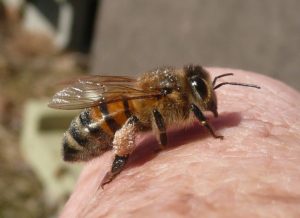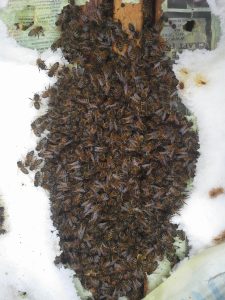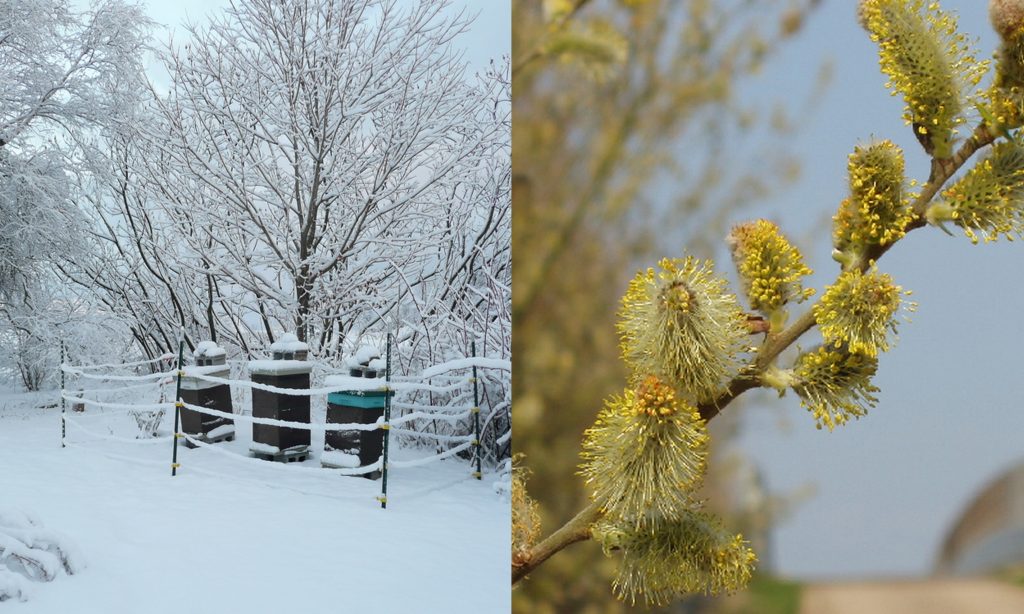Live from the Hive: April 2013
“Pollen!” By Annie Watson
 The bees were busy in the warm weather yesterday. The workers came back to the hive looking like they’d spent some time in a bakery — all dusted with very light tan pollen. It could be red maple, or maybe elm — I’m not sure. Red maples bloom around this time. Now, on warm days, the bees can feed their young, and the more food that’s available the more numerous and stronger the colony will be come summer. Nectar and pollen producing plants promote brood rearing and wax production — both important to the “spring buildup” of the colony.
The bees were busy in the warm weather yesterday. The workers came back to the hive looking like they’d spent some time in a bakery — all dusted with very light tan pollen. It could be red maple, or maybe elm — I’m not sure. Red maples bloom around this time. Now, on warm days, the bees can feed their young, and the more food that’s available the more numerous and stronger the colony will be come summer. Nectar and pollen producing plants promote brood rearing and wax production — both important to the “spring buildup” of the colony.
We love these warm days when the sun is shining and the bees are overjoyed to be out after the long winter cooped up in the hive. It’s so live affirming to see them bringing food back to the hive. I was blessed by one bee visiting my hand before she delivered her load. Note the blob of pollen basket on her back leg.
For more about pollen plants, check out this slide show from the Northeast Kansas Beekeepers’ Association.
 Starting around March 20 each season, we make the rounds in the scattered patches of snow and check on how our honey bees came through the winter. I look forward to being out on the land, and though the days can be cold and raw, there is a great warmth in the returning of the light and promise of Spring in the air. We delight in seeing the bees that are alive, these hives having made it through our long Northern winter. This is entwined with the sadness of finding that some of the bee hives did not make it and are dead. Often, the bees that have passed on have a box of honey left, that they do not need, and this is moved to the bee hives that are alive, and often light in weight and in need of honey. The hives with insufficient stores would not make it to the days of Spring when the flowers will provide them with enough nectar and pollen to sustain their lives. In transferring the honey from one hive to the next, I feel a renewed relationship with the bees and the help that we give them.
Starting around March 20 each season, we make the rounds in the scattered patches of snow and check on how our honey bees came through the winter. I look forward to being out on the land, and though the days can be cold and raw, there is a great warmth in the returning of the light and promise of Spring in the air. We delight in seeing the bees that are alive, these hives having made it through our long Northern winter. This is entwined with the sadness of finding that some of the bee hives did not make it and are dead. Often, the bees that have passed on have a box of honey left, that they do not need, and this is moved to the bee hives that are alive, and often light in weight and in need of honey. The hives with insufficient stores would not make it to the days of Spring when the flowers will provide them with enough nectar and pollen to sustain their lives. In transferring the honey from one hive to the next, I feel a renewed relationship with the bees and the help that we give them.